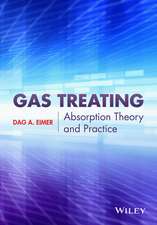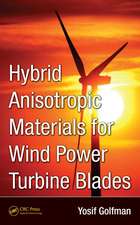Energy: The History of Wind Energy, Electricity Generation from the Wind, Types of Wind Turbines, Wind Energy Potential,
Editat de Thecapitol Neten Limba Engleză Paperback – 30 sep 2010
After experiencing strong growth in the mid-1980s, the U.S. wind industry hit a plateau during the electricity restructuring period in the 1990s and then regained momentum in 1999. Industry growth has since responded positively to policy incentives.
Although wind power currently provides only about 1% of U.S. electricity needs, it is growing more rapidly than any other energy source.
Wind power has negligible fuel costs, but high capital costs. The estimated average cost per unit incorporates the cost of construction of the turbine and transmission facilities, borrowed funds, return to investors (including cost of risk), estimated annual production, and other components, averaged over the projected useful life of the equipment, which may be in excess of twenty years.
Modern wind turbines fall into two basic groups: the horizontal-axis variety and the vertical-axis design. Utility-scale turbines range in size from 100 kilowatts to as large as several megawatts. Larger turbines are grouped together into wind farms which provide bulk power to the electrical grid. Single small turbines (below 100 kilowatts) are used for homes, telecommunications dishes, or water pumping. Small turbines are sometimes used in connection with diesel generators, batteries, and photovoltaic systems. These systems are called hybrid wind systems and are typically used in remote, off-grid locations where a connection to the utility grid is not available.
A key challenge for wind energy is that electricity production depends on when winds blow rather than when consumers need power. Wind's variability can create added expenses and complexity in balancing supply and demand on the grid. Recent studies imply that these integration costs do not become significant (5%-10% of wholesale prices) until wind turbines account for 15%-30% of the capacity in a given control area.
Opposition to wind power arises for environmental, aesthetic, or aviation security reasons. New public-private partnerships have been established to address more comprehensively problems with avian (bird and bat) deaths resulting from wind farms. Some stakeholders oppose the construction of wind plants for visual reasons, especially in pristine or highly-valued areas.
Wind technology has improved significantly over the past two decades, and wind energy has become increasingly competitive with other power generation options. Federal wind power policy has centered primarily on the production tax credit (PTC), a business incentive to operate wind facilities. The PTC was extended through 2013. While wind energy still depends on federal tax incentives to compete, key uncertainties like climate policy, fossil fuel prices, and technology progress could dominate future cost competitiveness.
Full Table of Contents, Sample Sections, and additional resources are available on the book's web site: www.TCNWind.com
Preț: 321.38 lei
Nou
Puncte Express: 482
Preț estimativ în valută:
61.49€ • 64.38$ • 50.88£
61.49€ • 64.38$ • 50.88£
Carte tipărită la comandă
Livrare economică 05-19 aprilie
Preluare comenzi: 021 569.72.76
Specificații
ISBN-13: 9781587331886
ISBN-10: 1587331888
Pagini: 812
Dimensiuni: 210 x 280 x 41 mm
Greutate: 1.79 kg
Ediția:New.
Editura: Thecapitol.Net,
ISBN-10: 1587331888
Pagini: 812
Dimensiuni: 210 x 280 x 41 mm
Greutate: 1.79 kg
Ediția:New.
Editura: Thecapitol.Net,
Descriere
Part of the government series on energy, from TheCapitol.Net, this text discusses the history of wind power in the United States.













